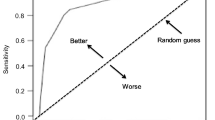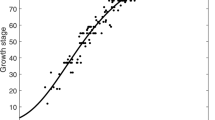Abstract
Bacterial black node (BBN) due to Pseudomonas syringae pv. syringae (PSS) is the most serious bacterial disease of barley in Japan. To help growers determine when to apply control measures against BBN, we developed a disease-forecasting model using a hierarchical Bayesian model (HBM) based on 29 years of data from Kagawa Prefecture (1992–2020), 19 years from Okayama Prefecture (2002–2020), and 8 from Yamaguchi Prefecture (2013–2020). The model included the number of fields with BBN in May of the previous season and the number of days at a minimum temperature (≤ − 4 °C) in January of the current season as predictors. The model was validated using a fivefold cross-validation (CV) procedure and achieved an average accuracy of 0.713, suggesting that this model can be used to predict the BBN incidence in May of the current season. This is the first report on developing a disease-forecasting model for BBN incidence using HBM based on a total of 56 years of historical data from three prefectures.


Similar content being viewed by others
References
Braun-Kiewnick A, Jacobsen BJ, Sands DC (2000) Biological control of Pseudomonas syringae pv. syringae, the causal agent of basal kernel blight of barley, by antagonistic Pantoea agglomerans. Phytopathology 90:368–375
Bull CT, de Boer SH, Denny TP, Firrao G, Ficher-Le Saux M, Saddler GS, Scortichini M, Stead DE, Takikawa Y (2010) Comprehensive list of names of plant pathogenic bacteria, 1980–2007. J Plant Pathol 92:551–592
Dye DW, Bradbury JF, Goto M, Hayward AC, Lelliott RA, Schroth MN (1980) International standards for naming pathovars of phytopathogenic bacteria and a list of pathovar names and pathotype strains. Rev Plant Pathol 59:153–168
Fukuda T, Azegami K, Tabei H (1990) Studies on bacterial black node of barley and wheat caused by Pseudomonas syringae pv. Japonica (in Japanese with English summary). Ann Phytopathol Soc Jpn 56:252–256
Gelman A, Carlin JB, Stern HS, Dunson DB, Vehtari A, Rubin DB (2013) Bayesian data analysis, 3rd edn. CRC Press, Boca Raton
Gelman A, Lee D, Jiqiang G (2015) Stan: A probabilistic programming language for Bayesian inference and optimization. J Educ Behav Stat 40:530–543
Goto K, Nakanishi I (1951) Ear burn, a new bacterial disease of barley (in Japanese with English summary). Ann Phytopathol Soc Jpn 15:117–120
Hoffman MD, Gelman A (2014) The No-U-turn Sampler: adaptively setting path lengths in Hamiltonian Monte Carlo. J Mach Learn Res 15:1351–1381
Hughes G, McRoberts N, Burnett FJ (2015) Information graphs for binary predictors. Phytopathology 105:9–17
Kawaguchi A (2013) PCR-RFLP identifies differences in hrpZ sequences to distinguish two genetic groups of Pseudomonas syringae pv. syringae strains from barley and wheat with bacterial black node. J Gen Plant Pathol 79:51–55
Kawaguchi A (2014) Risk factors for bacterial spot on peach in Okayama Prefecture, Japan. J Gen Plant Pathol 80:435–442
Kawaguchi A (2020) Risk factors and assessments for bacterial black node on barley. J Gen Plant Pathol 86:193–198
Kawaguchi A, Tanina K, Takehara T (2017) Molecular epidemiology of Pseudomonas syringae pv. syringae strains isolated from barley and wheat infected with bacterial black node. J Gen Plant Pathol 83:162–168
Kawaguchi A, Yoshioka R, Mori M, Nishimura F, Kawata K, Tomioka K, Takehara T (2018) Spatiotemporal distribution of barley and wheat plants naturally infected with bacterial black node in fields in western Japan. J Gen Plant Pathol 84:35–43
Mandrekar JM (2010) Receiver operating characteristic curve in diagnostic test assessment. J Thorac Oncol 5:1315–1316
Mukoo H (1955) On the bacterial black node of barley and wheat and its causal bacteria. In: Publication Society of Jubilee Publication in Commemoration of the Sixtieth Birthdays of Prof. Yoshihiko Tochinai and Prof. Teikichi Fukushi, Sapporo, Japan (in Japanese), pp 153–157
Oba S, Saito S, Sato M, Ishigaki H, Tanaka T, Uzuki T (1990) On the occurrence of bacterial black node of wheat in Shonai Region of Yamagata Prefecture (in Japanese). Annu Rept Plant Prot Nh Jpn 41:50–52
Shimada S, Sakai K (2017) Control of bacterial black node of wheat and barley by fungicide application (in Japanese). Plant Prot 71:383–386
Sing T, Sander O, Beerenwinkel N, Lengauer T (2005) ROCR: visualizing classifier performance in R. Bioinformatics 21:3940–3941
Turechek WW, Wilcox WF (2005) Evaluating predictors of apple scab with receiver operating characteristic curve analysis. Phytopathology 95:679–691
Yamashiro M, Waki T, Morishima M, Fukuda T (2011) Occurrence of barley bacterial black node (Pseudomonas syringae pv. japonica) in Tochigi Prefecture and its control by barley seed disinfection treatments (in Japanese). Annu Rep Kanto-Tosan Plant Prot Soc 58:9–12
Youden WJ (1950) Index for rating diagnostic tests. Cancer 3:32–35
Acknowledgements
I am grateful to Drs. Sun Jianqiang and Shigeki Kishi (RCAIT, NARO, Tokyo, Japan) for much useful advice on statistical analyses using HBM. I also thank the staff at the Okayama Plant Protection Office (Akaiwa, Okayama, Japan), the Kagawa Plant Protection Office (Ayakawa, Kagawa, Japan), and the Yamaguchi Plant Protection Office (Yamaguchi, Yamaguchi, Japan) for gathering the historical data on the incidence of BBN.
Author information
Authors and Affiliations
Corresponding author
Ethics declarations
Conflict of interest
The author declares that he has no conflict of interest.
Ethical standards
This article does not contain any studies with human participants or animals performed by the author.
Additional information
Publisher's Note
Springer Nature remains neutral with regard to jurisdictional claims in published maps and institutional affiliations.
Supplementary Information
Below is the link to the electronic supplementary material.
10327_2021_1035_MOESM1_ESM.pptx
Supplementary Fig. S1. Mean total precipitation and air temperature (±SD) between January and March from 2002 to 2020 in Okayama (Okayama City), from 1992 to 2020 in Kagawa (Ayakawacho), and from 2013 to 2020 in Yamaguchi (Yamaguchi City)
10327_2021_1035_MOESM2_ESM.pptx
Supplementary Fig. S2. Proportion of fields with bacterial black node in mid-May in Okayama (2002–2020), Kagawa (1992-2020), and Yamaguchi (2013–2020)
Rights and permissions
About this article
Cite this article
Kawaguchi, A. Model-based forecasting of bacterial black node of barley using a hierarchical Bayesian model. J Gen Plant Pathol 88, 48–54 (2022). https://doi.org/10.1007/s10327-021-01035-4
Received:
Accepted:
Published:
Issue Date:
DOI: https://doi.org/10.1007/s10327-021-01035-4




